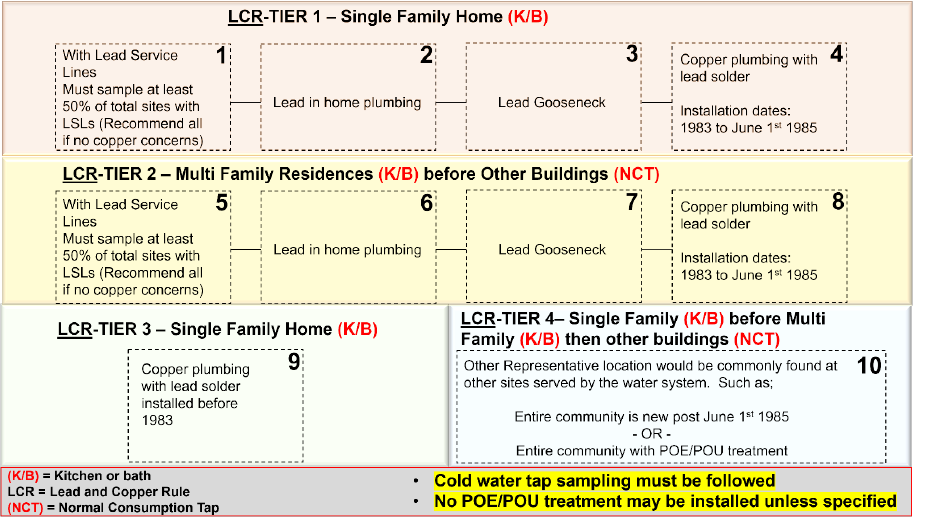
1
Frequent Asked Questions (FAQ) with Responses
for Lead/Copper Site Plan Template
MAY 14, 2024
1. Where do we find the site plan template and more information regarding the site plan
template for lead/copper?
Response: The site plan template can be found on the MDH webpage Lead and Copper Site
Plan Updates
(https://www.health.state.mn.us/communities/environment/water/lcsiteplan.html). This
webpage includes:
▪ The excel workbook which includes the template.
▪ A factsheet guideline on how to use the excel workbook.
▪ The record of participation form to note the resident/owner doesn’t want to participate in
the sample collection.
▪ Information on how to submit the completed excel workbook.
▪ Video webinar on how to use the excel workbook.
2. Can we use sites that were used in previous sampling periods to complete the site plan
template?
Response: Yes, you may be able to use some of your previous sample sites for sampling. You
would still need to confirm all the information about the site in the spreadsheet to determine
the tier number. Your system must attempt to get samples collected from the highest priority
sites available in the distribution for compliance sampling. You are only allowed to go to a
higher tier number when there are not enough lower tier sites to get all the required samples
collected (Figure 1). For example, you can only look to Tier 2 sample sites when you have used
all the available Tier 1 sample sites. It is important to note there even is a priority within each
some of tiers, see image below that may assist in identifying appropriate site priority. Your
historical sites may not be the highest priority sites available to your system for sample
collection. Follow the flow chart on SHEET-2 of the excel workbook to identify the highest
priority sites that should be used for sampling, then locate those sites in your system for the
site approval spreadsheet. Obtain MDH approval and then proceed to sampling.

FREQUENT QUESTIONS AND ANSWERS (FAQ) FOR LEAD/COPPER SITE PLAN
TEMPLATE
2
Figure 1 | Tier priority flowsheet. The diagram illustrates the hierarchy of site selection, organized into four
priority tiers, with "Tier 1" being the highest and "Tier 4" the lowest. Within each tier, sites are further prioritized
numerically as 1, 2, 3, and so forth. Selection should commence from the highest priority site in Tier 1 and proceed
sequentially to the lower priority sites in subsequent tiers.
3. The instructions state that sites with POU/POE devices (such as softeners) are not
allowed. What if majority of our sites have those devices installed?
Response: You can collect from sites with POU/POE, but if there is a single home in the
distribution without a softener or treatment device that is a site your system must attempt to
use for sample collection. If all the sites you’ve used previously have softeners, we recommend
investigating other sites in the distribution to see if there are any homes that would be without
treatment and a higher priority for sample collection. Ultimately, your system needs to
document that there aren’t any untreated homes available or willing to participate in sample
collection for samples from treated homes to be valid.
4. If we know that all sites have lead service lines (LSL), do we still need to complete
inspections or have conversations with the resident home to confirm the site
information?
Response: Yes, it must be confirmed if the site has a POU/POE installed to determine the Tier.
At this time the internal plumbing can be determined as well. When LSLs are present, the
internal plumbing could be listed as “Other” as it wouldn’t affect the tier. However, if or when
the LSL is replaced the internal plumbing will be needed to confirm the tier number. Thus, this
should be obtained and confirmed at the same time as the POU/POE is confirmed. You will
need to fill in the site material information in the excel workbook.

FREQUENT QUESTIONS AND ANSWERS (FAQ) FOR LEAD/COPPER SITE PLAN
TEMPLATE
3
5. How do we identify the presence of lead goosenecks? Do we abandon lower priority sites
in favor of sites with lead goosenecks? What about galvanized service lines?
Response: This information can be assessed to the best of the operator or engineer’s
knowledge on previous building installation records, or general physical inspections. Yes, if you
have sites that have confirmed known lead goosenecks present, those sites take priority within
Tier 1 after lead service lines (LSLs) and after lead interior plumbing because the lead from a
gooseneck has less risk than LSL and lead internal plumbing pipes. Under the current rule, you
would want to prioritize homes with lead goosenecks over the homes built in 1983-1985 with
copper pipe/lead solder but after LSL or lead internal pluming pipe. You don't need to
incorporate galvanized service lines under the current rule, but those would become a priority
in the future under LCRI unless those locations are proved to never be downstream of lead
(lead gooseneck, pigtail, or connector).
6. Is this site plan template the same thing as the service line inventory template?
Response: No, these two templates are different and not the same. This template is used for
the lead/copper sampling related to your lead and copper scheduled sampling. This template
only needs to provide information as it relates to the highest priority sites your system must
sample. The number of sites your water system must sample is shown on your lead/copper COC
along with the Annual Monitoring schedule for your system.
Additional table describing this is below based on population:
7. Can I update the site plan template in future if site information changes?
Response: Yes. If the system would like to change the selected sites on their chain of custody
(COC) form, they can resubmit the excel workbook template with the new sites they want to
add. The replaced site must be of the same tier priority or higher (if they are available) before
selecting lower tier priority sites. Additionally, the record of participation form (present on the
MDH webpage Lead and Copper Site Plan Updates
(https://www.health.state.mn.us/communities/environment/water/lcsiteplan.html)) needs to
be filled for each site replaced unless there is a materials/construction change made at the site
location that changes the tier for the prior approved sites. The filled our form or spreadsheets
would need to be sent to MDH for a site change approval.

FREQUENT QUESTIONS AND ANSWERS (FAQ) FOR LEAD/COPPER SITE PLAN
TEMPLATE
4
8. What if the owner/resident of the site does not want to participate or refuses to take part
in lead/copper sampling, even though their tier is a higher priority (i.e., Tier 1)?
Response: In this case, a record of participation form (in the MDH webpage) would need to be
completed to note that the site was inaccessible. The filled form would need to be sent to MDH
and documented by the system to move to another site and request approval of another site if
necessary.
9. How is the PWS supposed to know internal plumbing material? Same with POE POU?
Response: This is the responsibly of the water system to determine prior to sampling. This is
required to ensure the site is an acceptable sample site for your water system. This may
involve calling the homeowner before providing bottles, performing a site visit, or other. This
can change over time also based on remodeling or new treatment installed, thus it should be
re-confirmed at time of sampling or prior to sending bottles to lab. If this changes and a site is
no longer valid, approval and a new site would be necessary to maintain compliance. Water
systems must work with the sites identified for sampling to identify this required information
prior to sampling. This could be conversations with the homeowner prior to selecting a site, a
site visit prior to sampling such as looking under the kitchen or bath sink prior to sampling, or
other.
10. Is lead solder considered lead internal plumbing?
Response: Lead Internal plumbing would be a full lead pipe. Please note these are rare but do
exist in some older homes. Copper plumbing with lead solder is not consider lead internal
plumbing. Note: When selecting the copper for internal plumbing drop down it is important to
consider if it is Copper with Lead Solder (CUP-LS) or just copper plumbing (Copper) free of
solder. Typically, if a water system does not know you can base this off your experiences in the
water system as a whole or use the general conclusion that homes pre 1985 are likely to have
Copper with Lead Solder (CUP-LS) in use.
11. Are any water systems exempt from this process?
Response: This applies to all community water systems, regardless of their size (population
size). Systems must preform this prior to next set of lead and copper sampling and then ensure
each and every future sampling pool and sites used are appropriate and approved.
12. Does every resident home need to be inspected/tested for?
Response: Systems only need to obtain enough sites to fulfill their required monitoring as
identified on your system annual monitoring schedule (AMS) or on Sheet 1 in the upper right
corner of the Site Plan Template Excel workbook. The water system inventory should be used to
determine which sites to start with via the process flow on Sheet 2 of the Site Plan Template
Excel workbook. This process is to ensure the highest priority sites are sampled for your sytem.
Minnesota Department of Health
Drinking Water Protection
651-201-4700
www.health.state.mn.us
05/14/24
To obtain this information in a different format, call:
651-201-4700.
